Introduction
India’s rapid growth and industrial expansion have unlocked enormous progress, but they’ve also brought serious environmental challenges we can’t ignore. One of the most overlooked of these is thermal pollution, which quietly affects rivers, lakes, and coastlines all over the country.
Whenever factories or power plants discharge heated water back into natural water bodies, they disrupt delicate ecosystems and endanger countless species. But this isn’t just about plants and fish. Thermal pollution also puts the livelihoods of millions of people—especially those who rely on fishing and farming—at risk.
In this guide, we’ll dive into real-world examples of how thermal pollution is changing India’s waterways, explore the impact it has on communities and wildlife, and look at the solutions that are already making a difference. Whether you’re an environmental advocate, a concerned citizen, or just curious, you’ll find practical insights and inspiring stories here. Down To Earth magazine articles on water pollution
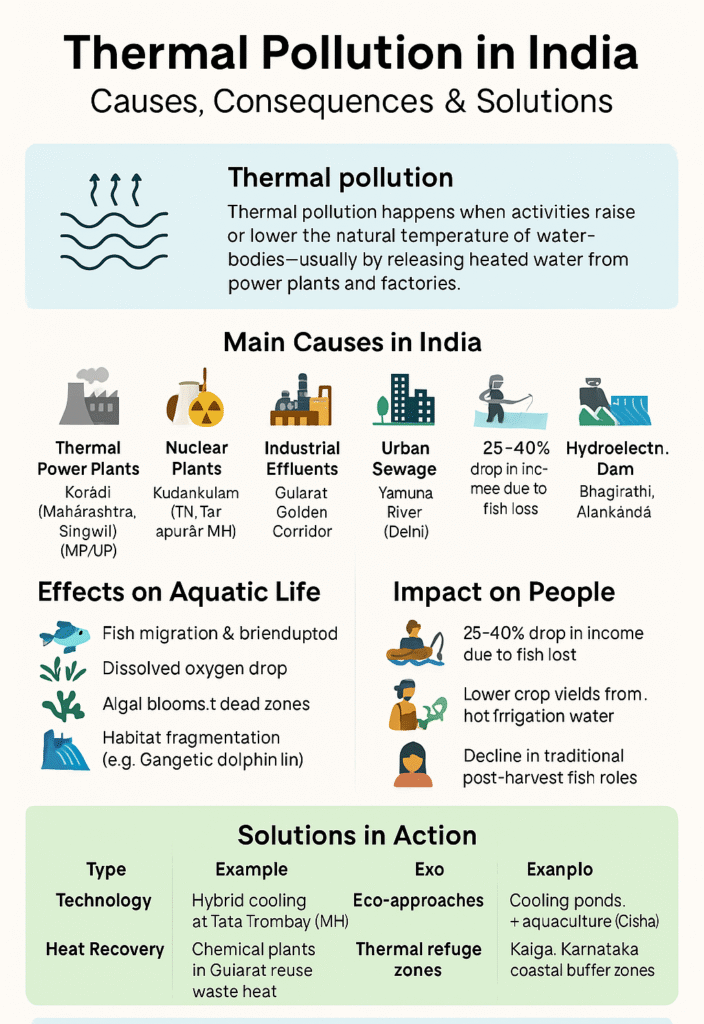
Table of Contents
What is Thermal Pollution?
Thermal pollution happens when industries use water to cool their machinery and then release it back into rivers or lakes at much higher temperatures, sometimes 5–10°C warmer than usual. In India, this is especially common around power plants and factories that depend on massive amounts of water to keep operations running smoothly.
Even a few degrees of temperature change can harm fish, disrupt breeding cycles, and reduce the oxygen levels that aquatic life needs to survive. Think of it as turning up the thermostat in an aquarium—suddenly, the entire environment is out of balance. [See how thermal pollution compares to chemical pollution in Indian waterways →] In India, this typically happens when power plants and factories discharge heated cooling water into rivers, lakes, or coastal areas.
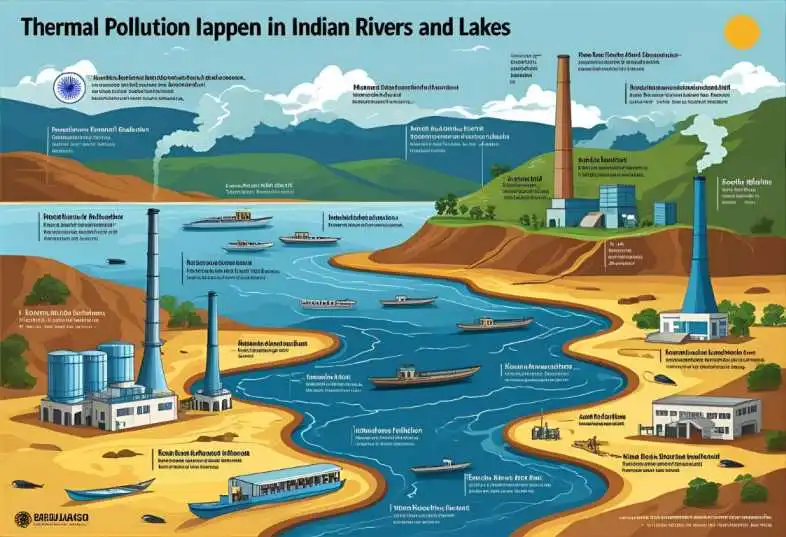
Definition and Basic Concept
When water temperatures deviate from natural ranges—even by just a few degrees—they can negatively affect aquatic organisms. Power plants commonly use water for cooling and discharge it at temperatures 5-10°C above ambient levels.
According to National Geographic, thermal pollution differs from chemical pollution because it alters physical conditions like temperature, not chemical composition. For healthy aquatic life in Indian freshwater ecosystems, water temperatures typically range between 24-30°C, depending on region and season.
Common Causes in the Indian Context
Primary sources of thermal pollution in India include:
- Thermal Power Plants: With over 200 coal-fired power plants nationwide, these facilities use vast quantities of cooling water that’s returned heated to nearby water bodies. The Singrauli region, India’s “energy capital,” hosts numerous plants discharging heated water into the Rihand Reservoir and the Son River.
- Nuclear Power Facilities: Plants like Kudankulam in Tamil Nadu and Tarapur in Maharashtra contribute to localized thermal pollution in coastal waters.
- Industrial Manufacturing: Steel mills, paper factories, chemical plants, and textile industries discharge heated wastewater across industrial clusters in Gujarat, Maharashtra, and Tamil Nadu.
- Urban Sewage Discharge: Major cities like Delhi, Mumbai, and Kolkata release untreated sewage that raises water temperatures, especially in smaller water bodies.
- Hydroelectric Dams: When cold water from reservoir depths is released, it creates “cold shock” downstream, affecting rivers like the Bhagirathi and Alaknanda.
India’s tropical climate compounds these issues, as water bodies already experience high ambient temperatures in the summer months.
Thermal Power Plants: Major Contributors
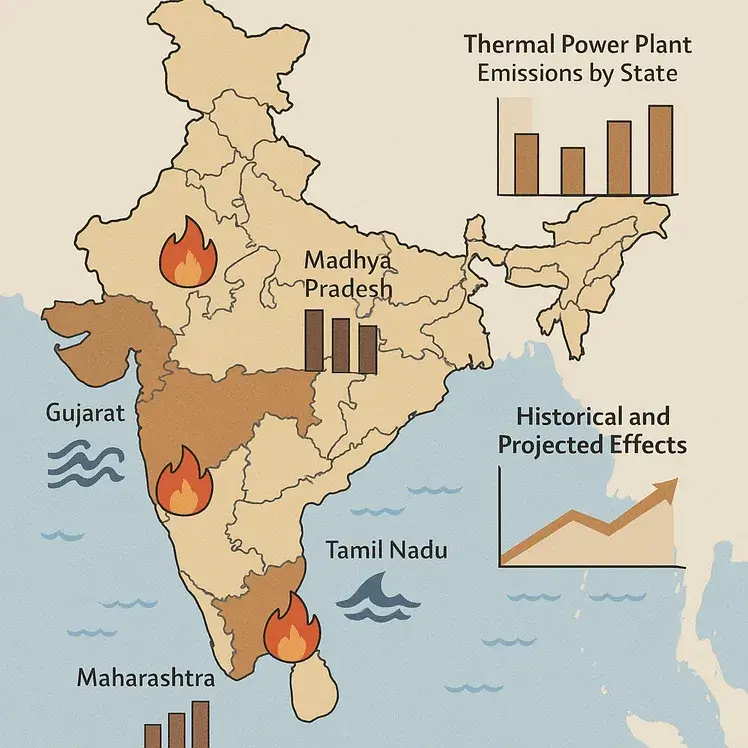
Thermal power plants contribute approximately 60% of India’s electricity generation capacity while being a significant source of thermal pollution nationwide.
Case Study: Koradi Thermal Power Station, Maharashtra
The Koradi Thermal Power Station near Nagpur offers a clear case study of thermal pollution impacts in central India. Water temperature increases of 8-9°C affect aquatic life and agricultural practices. This 2,600 MW plant draws water from the Kanhan River and returns heated effluent to nearby water bodies.
Studies show water temperatures in receiving channels are consistently 8-9°C higher than ambient levels.
Local fishermen report significant changes in fish populations, with native species like rohu and catla declining dramatically.
Farmers have observed that heated water seeping into irrigation channels affects crop yields, particularly for temperature-sensitive crops. Some report up to 30% yield reductions in plots nearest to discharge channels.
Recent news articles about thermal pollution incidents

The Rihand Reservoir Crisis in Singrauli
The Singrauli region, spanning Madhya Pradesh and Uttar Pradesh, hosts multiple large thermal power plants with a combined capacity exceeding 10,000 MW. These plants discharge heated effluent into Rihand Reservoir, raising water temperatures by 6-8°C above normal in discharge zones.
The ecological consequences include fish kills during summer months and declining biodiversity. The reservoir once supported over 40 fish species, but recent surveys show diversity has declined to fewer than 25 species. Fish breeding is highly temperature-sensitive, as explored in our detailed piece on aquatic reproduction and pollution.
Warmer water has accelerated algal blooms, creating eutrophication that further depletes oxygen levels. This impacts thousands of fisherfolk who depend on the reservoir for their livelihoods.
Industrial Effluents and Urban Discharge
Beyond power generation, industrial sectors and urban areas contribute significantly to thermal pollution through various effluent discharges.
Industrial Corridor: The Gujarat Coast Example
Gujarat’s coastal industrial belt hosts one of India’s highest concentrations of chemical, petrochemical, and manufacturing facilities. In the Golden Corridor industrial zone, factories release cooling water and process effluents into the Kolak and Damanganga rivers before they enter the Arabian Sea.
Monitoring has documented temperature increases of 4-7°C in estuarine zones.
The Jamnagar coastal area, home to massive petroleum refineries, shows thermal plumes extending several kilometers into the Gulf of Kutch, contributing to coral bleaching events in the nearby Marine National Park.
Traditional fishing communities report changing fish migration patterns and declining catches by up to 40% over two decades.
Urban Heat Islands: The Yamuna River in Delhi
The Yamuna River receives approximately 3,800 million liters of sewage daily from Delhi, much of it untreated. Monitoring data shows river temperatures increase by 2-3°C flowing through the urban corridor, particularly downstream from major sewage outfalls.
The heated urban river creates conditions where water holds less dissolved oxygen, while biological processes that consume oxygen accelerate. During summer months, portions of the Yamuna become completely oxygen-depleted, creating “dead zones” where only pollution-tolerant organisms survive.
Ecological Impacts: How Thermal Pollution Affects Indian Aquatic Ecosystems
Thermal pollution disrupts the delicate balance of aquatic ecosystems across India, triggering cascading effects through food webs and ecological communities.
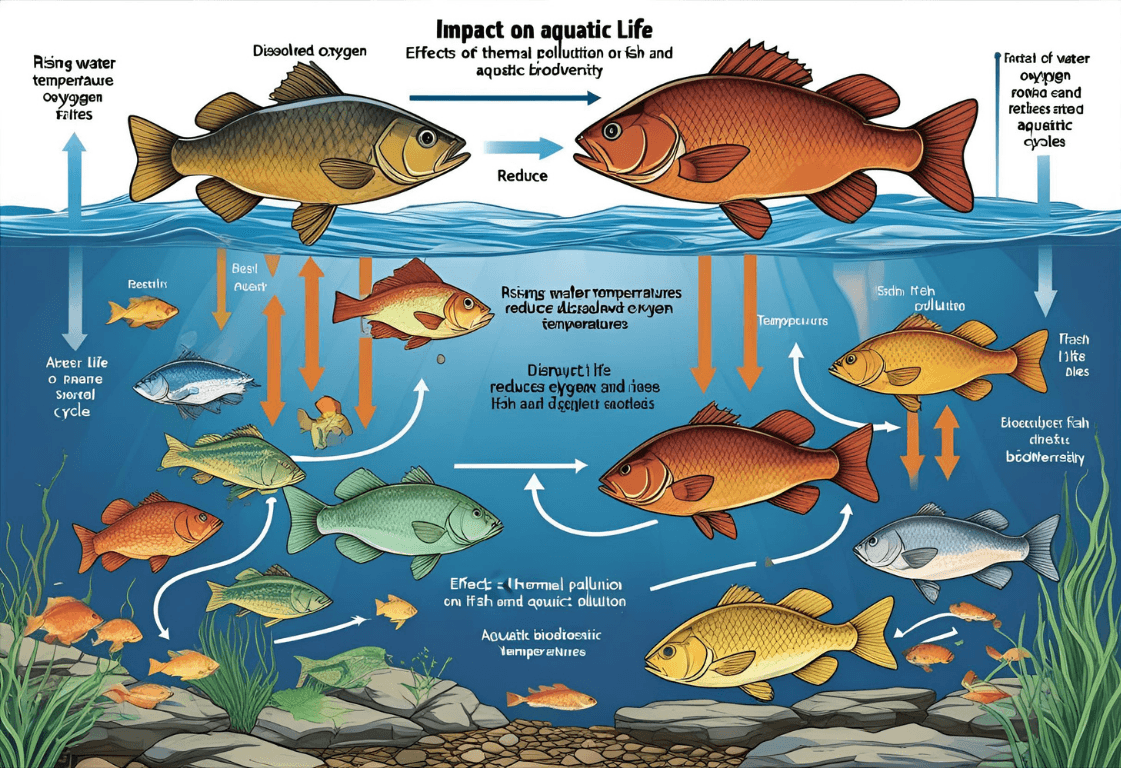
Disruption of Aquatic Ecosystems in the Ganges Basin
The Ganges River system faces thermal inputs from multiple sources along its course. Research has documented temperature variations up to 6°C downstream from major thermal discharges, disrupting reproductive cycles of native fish species that rely on seasonal temperature cues for spawning.
The endangered Gangetic dolphin shows altered distribution patterns in response to thermal pollution. These dolphins rely on prey fish that avoid thermally polluted zones, effectively fragmenting dolphin habitats. Studies also indicate that the river’s unique bacteriophage community, which helps break down organic waste, functions optimally only within specific temperature ranges, meaning thermal pollution reduces the river’s natural self-purification capacity.
Environmental science journals with thermal pollution studies
Chilika Lake’s Changing Biodiversity
Chilika Lake, Asia’s largest brackish water lagoon and a Ramsar wetland site in Odisha, shows how thermal pollution affects coastal ecosystems. Research documents shifts in phytoplankton communities, with warmer waters favoring certain blue-green algae species that can produce toxins.
Fish community structure has changed in thermally affected areas, with cold-water dependent species declining while heat-tolerant invasive species expand. Ornithologists have documented changes in arrival times and duration of stay for several migratory bird species as their food sources are affected by thermal pollution.
Socioeconomic Consequences of Rising Water Temperatures in India
The effects of thermal pollution don’t stop with plants and fish. They ripple out into the lives of people who depend on these waters to make a living.
For example, in the Narmada River basin, local fishermen have seen their catches drop dramatically as fish either die off or move elsewhere. In Tamil Nadu’s coastal villages, traditional fishing families are forced to travel farther out to sea because warmer water near the shore drives fish away. This not only hurts incomes but also makes fishing trips more dangerous and expensive.
And it’s not just fishing communities feeling the impact. Farmers who use this warm water for irrigation are noticing lower crop yields and more pests, which adds to their struggles.
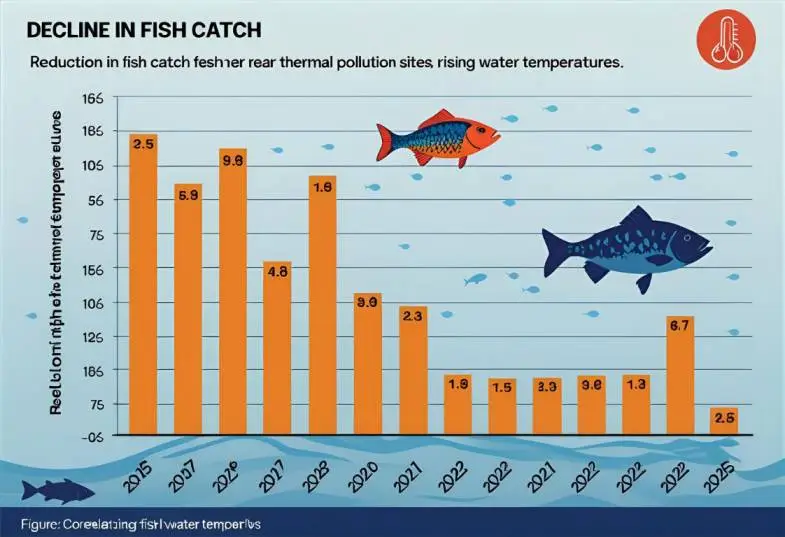
Impact on Fisheries and Dependent Communities
Along the Narmada River basin, thermal discharges have altered fish populations that sustain thousands of traditional fishing families. In the Bargi reservoir region, fishermen report a 25-35% income reduction over the past decade as commercially valuable species decline.
In coastal Tamil Nadu, traditional fishing communities have documented shifting fish migration patterns due to thermal “barriers” that some species avoid. This forces fishermen to travel farther from shore, creating economic hardship and safety risks. Women in fishing communities, who traditionally handled post-harvest processing and local sales, have been particularly affected as their role in the value chain is disrupted.
Agricultural Implications near Thermal Pollution Sources
In the Damodar Valley region, irrigation with thermally polluted water shows negative effects on agriculture. Studies document that warmer irrigation water accelerates soil microbial activity, potentially depleting organic matter more rapidly. For temperature-sensitive crops, yield reductions of 15-20% have been observed.
In Chhattisgarh’s rice-growing regions near power plants, farmers have observed accelerated pest multiplication rates with warmer irrigation water, increasing production costs through greater pesticide dependency.
Are you a farmer concerned about irrigation water quality? [Check our guide: Identifying Water Pollution in Irrigation Sources ]
Regulatory Framework and Compliance Challenges
India has established various regulations to control thermal pollution, guided in part by the Central Pollution Control Board (CPCB), yet significant gaps exist between policy and implementation.
India’s Environmental Regulations on Thermal Discharges
Key regulations include:
- The Water (Prevention and Control of Pollution) Act, 1974
- Environmental Protection Act, 1986
- Thermal Power Plant Regulations limiting discharge temperature to no more than 5°C above the receiving water body temperature
- Coastal Regulation Zone (CRZ) Notification
- Environmental Impact Assessment (EIA) Requirements
Implementation Gaps and Enforcement Challenges
Despite robust regulations on paper, implementation faces challenges:
- Limited Monitoring Infrastructure: Pollution Control Boards lack sufficient real-time temperature monitoring systems.
- Technical Capacity Constraints: Many state boards face shortages of qualified technical staff.
- Inadequate Penalties: Fines are often insufficient to incentivize compliance.
- Regulatory Overlaps: Multiple agencies with jurisdiction create coordination challenges.
Innovative Solutions and Success Stories
Despite challenges, several regions have implemented effective approaches to manage thermal pollution.
Technological Interventions: Cooling Systems and Heat Recovery
The Tata Power plant in Trombay upgraded from once-through cooling to a hybrid cooling system with water recirculation, reducing discharged water temperature by nearly 8°C. In Gujarat’s chemical sector, companies have implemented heat recovery systems that capture thermal energy from wastewater streams before discharge, simultaneously reducing pollution and energy costs.
In Tiruppur, Tamil Nadu, a common effluent treatment plant serving textile units integrated an absorption chiller system that transforms waste heat into useful cooling energy while ensuring discharged water meets temperature standards.
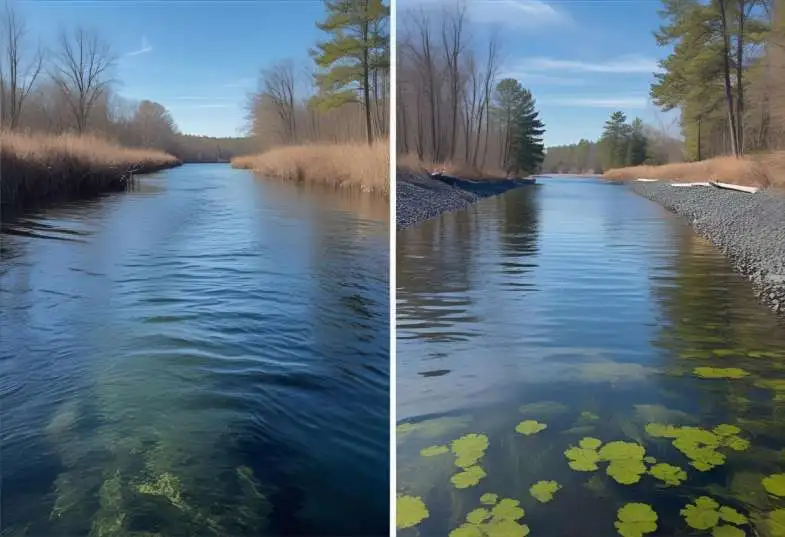
Ecological Approaches and Nature-Based Solutions
In Odisha, the Integrated Cooling Pond Ecosystem approach routes heated discharge through engineered wetlands and aquaculture ponds before release. These systems cool water naturally while creating productive aquaculture opportunities using warm-water-tolerant fish species.
In the Rihand reservoir region, NTPC has developed “thermal refuge zones” with native aquatic vegetation and shaded areas, providing habitat for native fish species during periods of elevated water temperatures. [See our detailed case study on successful thermal refuge zone implementations ]
In coastal areas near Karnataka’s Kaiga nuclear power plant, mangrove restoration projects create buffer zones that naturally moderate temperature fluctuations.
The Way Forward: Policy Recommendations and Individual Actions
Addressing thermal pollution requires action at multiple levels, from policy reforms to community engagement. Citizen Science Initiatives: Community-based temperature monitoring programs.
Policy Reforms and Institutional Strengthening
Recommended improvements include:
- Improved Monitoring Networks: Comprehensive automated temperature monitoring stations with public data access
- Differential Standards by Ecosystem Type: Regulations tailored to varying thermal sensitivities of different water bodies
- Integrated Watershed Management: Incorporating thermal pollution into broader watershed governance frameworks
- Economic Incentives: Tax benefits for implementing advanced cooling technologies
- Research and Development Support: Funding for locally appropriate cooling technologies
Ministry of Environment, Forest and Climate Change
Community Engagement and Individual Actions
Beyond policy reforms, engaging communities is essential:
- Citizen Science Initiatives: Community-based temperature monitoring programs
- Consumption Choices: Energy conservation to reduce demand from thermal power plants
- Supporting Sustainable Fisheries: Purchasing from community-managed fisheries using adaptive practices
- Educational Outreach: Integrating water monitoring into environmental education
- Advocacy for Corporate Responsibility: Encouraging voluntary adoption of higher standards
Conclusion
Thermal pollution might not get as much attention as air or plastic pollution, but it’s one of the biggest threats facing India’s rivers and lakes today. From the Rihand Reservoir in the north to the coastal waters of Tamil Nadu in the south, this problem is changing ecosystems and making life harder for countless communities.
But there’s hope. New technologies, smarter policies, and community-led projects are already proving that solutions are within reach. By raising awareness, supporting innovation, and holding industries accountable, we can protect these precious water resources for generations to come.
The question is: What role will you play in keeping India’s waters cool and healthy?
As India continues developing, balancing economic growth with environmental protection requires dedicated attention to often-overlooked challenges like thermal pollution. By strengthening regulations, implementing innovative solutions, and engaging communities as active partners, India can transform its approach to thermal management, protecting its precious water resources for future generations. [Check our guide: Identifying Pollution Sources ]
The time for action is now for the health of our rivers, the protection of our aquatic biodiversity, and the well-being of communities dependent on these resources. What role will you play for cooler, healthier waters across India?
Need a Summary or Quiz for Class?
Download Thermal Pollution Summary & Quiz PDF with infographic, summary & mini-quiz with infographic, summary & mini-quiz
Frequently Asked Questions About Thermal Pollution in India
What is thermal pollution, and how does it occur in India?
Answer:
Thermal pollution refers to the rise or fall in the temperature of natural water bodies caused by human activities. In India, this mostly happens when power plants, industries, or urban sewage discharge heated water into rivers, lakes, or coastal zones, disrupting the natural temperature balance and affecting aquatic life.
Which industries are the biggest contributors to thermal pollution in India?
Answer:
Thermal power plants are the largest contributors, followed by nuclear power stations, steel and chemical industries, textile factories, and urban sewage systems. These facilities often use water for cooling processes and release it back at elevated temperatures.
What are some real-life examples of thermal pollution in India?
Answer:
Koradi Thermal Power Station, Maharashtra: Causes localized temperature spikes affecting fish and crop yields.
Rihand Reservoir, Singrauli: Impacted by multiple power plants, leading to reduced fish diversity and eutrophication.
Kolak and Damanganga Rivers, Gujarat: Polluted by industrial discharges from the Golden Corridor zone.
Yamuna River, Delhi: Suffers from elevated temperatures due to untreated urban sewage inflow.
How does thermal pollution affect aquatic ecosystems?
Answer:
It alters water temperature, which can:
Reduce dissolved oxygen levels
Kill sensitive aquatic species
Disrupt breeding and migration patterns
Promote the growth of harmful algae
Change the natural food web and biodiversity
“Download Thermal Pollution Summary & Quiz PDF with infographic, summary & mini-quiz” with infographic, summary & mini-quiz
What are the consequences of thermal pollution for local communities?
Answer: Thermal pollution affects:
Fishermen: Fish population decline leads to reduced income.
Farmers: Warmer water for irrigation lowers crop yields and increases pest activity.
Women: Disruption in traditional fish processing and sales roles.
What regulations exist in India to control thermal pollution?
Answer: Key regulations include:
The Water (Prevention and Control of Pollution) Act, 1974
Environmental Protection Act, 1986
Thermal power plant discharge temperature norms
Environmental Impact Assessments (EIA). However, enforcement remains a challenge due to monitoring gaps and limited penalties.
Want to learn more about the Effects of Thermal Pollution on Aquatic Ecosystems?
- What is Thermal Pollution? Causes, Effects, and Solutions Explained→
- Causes of Thermal Pollution: Human vs Natural Sources
- Effects of Thermal Pollution on Aquatic Ecosystems: Causes, Case Studies & Solutions
- Solutions to Thermal Pollution: 7 Ways to Reduce It
About the Author
Soumen Chakraborty is an environmental writer who is passionate about sustainable solutions. He has researched and written about environmental issues for two years, breaking down complex topics into practical, actionable insights.
Share this article to raise awareness about thermal pollution.

